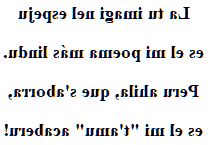Extremaduran love poem
L'espeju
La tu imagi nel espeju
Es el mi poema más lindu.
Peru ahila, que s'aborra,
Es el mi "t'amu" acaberu!


→ French poem ←
Extremaduran
Extremaduran (variants : Estremeñu, Bahu Ehtremeñu, Cahtúo (Cahtúö), Meyu Ehtremeñu, Central Extremaduran, Barranquenho, Barranquian, Southern Extremaduran, Artu Ehtremeñu, Extremeño, Northern Extremaduran, Autonyme : Barranquênhu, Ehtremeñu) is a group of dialects spoken in Extremadura and Portugal by 200,000 people.
As an Iberian-Romance language, so descendant of Latin, it can be considered in its variants as a transition between Eastern Leonese and Andalusian Castilian.
In Extremadura there are three languages which have been able to withstand time without changing too much. These are the Portuguese of La Raya, Ehtremeñu and Fala.
The Extremaduran is an oral language which will not have started to see written attempts until tardy (end of XIVth century).
Extremadura, which was a part of the Kingdom of Leon, will see the formation of the different forms of Extremaduran with the merger of the kingdoms of Castile and Leon.
Extremadura
Extremadura was first integrated in the Roman province of Lusitania, then in 569 annexed to the Visigothic kingdom, then invaded by the Moors (711) (caliphate of Damascus, caliphate of Cordoba), to form then in 960 an independent Arab kingdom.
170 years later, the region will be liberated by Alfonso IX of León (1230) and will provide, not only the two famous conquistadors Cortes (Aztec) and Pizzaro (Inca), but also Pedro de Valdivia (Chile), Orellana (amazon) et Nunez de Balboa (Pacific). Extremadura in Spain today corresponds to the provinces of Cáceres and Badajoz.